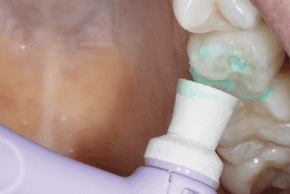Rubber Cup Polishing for Biofilm Control

Rubber cup polishing has been an effective method for completing prophylaxis and controlling biofilm growth, and on-going research has expanded dentistry’s knowledge regarding the
formation, growth, development, behavior, and effects of biofilm. Further, material developments and the subsequent introduction of selective polishing performed at the clinician’s discretion
may be appropriate for properly managing oral biofilm. The colonization of bacteria within the oral cavity begins at birth and constantly changes with age.1 Initially, single planktonic cells develop throughout the oral cavity, creating ecosystems in which bacteria, principally Streptococci, reside on tooth surfaces to form the first stages of biofilm.2
What is Biofilm?
Biofilm describes the generic community of colonized cells on a surface. Dental plaque biofilm includes all of the characteristics of biofilm architecture and microbial community interaction, but more specifically it develops in the oral cavity, consists of more than 700 contributing oral microbial species, and demonstrates a distinct method of conditioning the tooth surface.4-7 Research has determined that dental plaque biofilm consists of highly specialized, coordinated
multi-species forms of microorganism life located permanently on the tooth surface in a matrix, surrounded by a layer of extracellular polysaccharides that ensure the microorganisms are more resistant to immunological defense systems and less susceptible to antimicrobials.5-7
Biofilm Growth and Development
Both beneficial and pathogenic bacteria coexist throughout the human body, and the key
for maintaining health in all systems is to establish balance. This balance, known as microbial homeostasis, brings stability to the environment through a dynamic balance of both synergistic and antagonistic microbial interactions.13 Breakdown of homeostasis in the oral microbiome can lead to changes in the microflora balance, potentially predisposing sites to disease due to the microbiological imbalance within the biofilm.13- 16 Processes of decreasing and increasing biofilm pH occur prior to the respective practices of tooth surface de- and re-mineralization.1 In healthy conditions, these processes occur without causing permanent tooth enamel surface damage, and with the balance of the system remaining in place.1 Therefore, oral health
maintenance occurs when biofilms are regularly disrupted.
Rubber Cup Polishing for Biofilm Disruption, Destruction and Control

In addition to basic oral hygiene habits, rubber cup polishing can be an appropriate strategy for biofilm disruption, destruction, and control.
Frequently used in initial or supportive periodontal therapy, rubber cup polishing devices can be effective for professional supragingival biofilm plaque removal.49 Previously, rubber cup polishing was utilized on every patient because it was believed to facilitate fluoride uptake. However, studies have demonstrated no evidence that rubber cup prophylaxis
improves fluoride uptake.50 Therefore, as an alternative, selective polishing maximizes the effectiveness of rubber cup prophylaxis when the clinician deems it appropriate to control and/or disrupt/destruct dental plaque biofilm and prevent disease. This positioning is based on research concerning enamel mineral loss caused by polishing that recommends limiting polishing to areas where a stain
cannot be removed by other methods.51 It is incumbent upon the clinician to determine when rubber cup polishing is necessary for biofilm control, since continuous polishing over time can cause morphological changes in tooth structure.52
Techniques & Equipment
The basic rubber cup polishing technique requires operators to provide safety glasses for the patient and use personal protective equipment. Using a cordless hand piece allows for easier
adjustments and improved ergonomics. After a comprehensive assessment, the patient should complete a pre-procedural rinse with an antimicrobial mouth rinse.
Instructions for Polishing
Polishing should begin with the distal surface of the most posterior tooth and move toward the anterior, polishing the gingival third to the incisal third of the tooth. The rubber cup should be filled with
the appropriate polishing agent and applied to the tooth surface. Using a low speed, the revolving cup is then lightly applied to the tooth surface with light pressure, ensuring the cup slightly flares and slightly slips into the sulcus. The pressure applied should be as light
as necessary to remove the biofilm and any stain. Using an intermittent patting motion, the rubber cup should then be moved to an adjacent area on the tooth surface. The position of the hand piece can be altered by turning or lifting it to adapt the rubber cup to the tooth surface. After treatment, continued education about rubber cup polishing, biofilm, and preventative maintenance is essential to controlling biofilm and preventing disease.
Although dental plaque biofilm development and growth is unavoidable, a variety of methods can be undertaken to control it. Basic oral hygiene, including proper brushing, flossing, and rinsing
with antimicrobial mouth rinses, disturbs and in some cases inhibits biofilm growth. Additionally, rubber cup polishing also helps to disrupt biofilm growth and control its development. Rubber cup polishing with a disposable prophy angle eliminates the risk of cross contamination, while providing an effective and efficient method of biofilm control.
